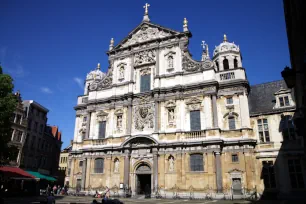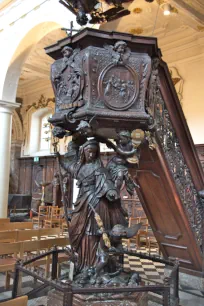With its striking Baroque facade, beautiful tower and opulent interior, the Church of St. Charles Borromeo is one of the most attractive buildings in Antwerp. It is located at the Hendrik Conscience-plein, a picturesque square reminiscent of Italy’s piazzas.
History
Counter-Reformation



After the invasion of Antwerp by Alexander Farnese in 1584 the Spanish invaders forced all Protestants to leave the city or convert to Catholicism within four years. Not only did this lead to an emigration of about half the city’s population in just two years, it also started the counter-reformation, a movement led by the Jesuits to counter the reformation of the Protestants. The most visible project of this movement was the construction of the Baroque church of St. Charles Borromeo.
Construction & Design
The church was constructed by a Jesuit, the physician and mathematician François d’Aguilon. After his death in 1617 he was succeeded by local architect Pieter Huyssens. Construction of the church started in 1614 and was completed just seven years later, in 1621, although interior work continued until 1626. The church was originally named Church of St. Ignatius, after the founder of the Jesuits, Ignatius of Loyola.
The design of the church was modeled after the Jesuits’ main church in Rome, the Chiesa del Gesù, which was built thirty years prior. Part of the decorations, including the original painted ceiling, were designed by local master painter Pieter Paul Rubens. No expenses were spared and the church was opulently decorated with the most expensive materials. The Jesuits even called their church the ‘marble temple’. They racked up so much debt as a result of the astronomical cost of the construction, that the Generalate in Rome forced austerity on them.
Fires
Lightning struck the church in 1718, starting a fire which destroyed much of the interior. The church was soon restored by J.P. Van Baurscheit I, but much of the interior – including the original marble in the nave and the 39 ceiling paintings by P.P. Rubens – was lost. Sketches of the paintings still exist and can be found in museums around the world.
Another fire occurred more recently, in 2009, but fortunately this time no important works of art were damaged.
Parish Church of St. Charles Borromeo
The Ignatius Church was sold by the Jesuits in 1733. And in 1773, when the pope disbanded the Jesuits, it was even closed for a while until it became a parish church in 1803. It was on this occasion that the church was renamed St. Charles Borromeo. Some of the most precious works of art were transferred to Vienna, while other items were sold off.

Facade
The Baroque facade of the church, in typical Jesuit style, is harmonious despite its elaborate and dynamic design which is meant to draw the attention of passers-by. In typical classical style it features the superposition of the columns following the three orders of Ancient Greek architecture: Doric columns on the bottom level, Ionic columns in the middle and Corinthian columns at the top. The columns divide the facade vertically into smaller segments.
Bottom section
The arched door of the main portal features a tympanum decorated with a relief of the sun. Trumpeting angels right above welcome visitors inside. A bit higher, right below the arch crowning the portal you can see the city’s coat of arms. The two statues in the niches on the left and right of the portal represent the apostles Peter and Paul.
Middle section

The most prominent spot in the middle of the second level is reserved for the IHS seal of the Jesuits. The seal is surrounded by a cluster of angels and topped by a gilded winged crown, symbolizing the power of angels. The seal is flanked by statues of two evangelists with their symbols shown below. On the left is Saint Matthew (with an angel) and on the right Saint Mark (with a lion).
Top section
At the center of the top level you can see the bust of Ignatius of Loyola, founder of the Jesuits. He is flanked by the two other evangelists: St. John (with an eagle) on the left, and St. Luke (with an oxen) on the right. The pediment above celebrates Mary, the first patron saint of the church.


Tower
The church has a single tower which sits at the eastern end of the church, right behind the apse. The tower, which reaches a modest height of 58 meters (190 feet), is considered the most beautiful in the city. When seen from the square in front of the church, it is obscured by the facade, but you can admire the tower from the Sint-Katelijnevest (the street that runs behind the church).
The tower is clearly divided into four sections. The base of the tower is decorated with large statues of angels, eucharistic symbols, and a cartouche with the IHS seal.
The level above features niches with statues of angels, framed by pilasters and columns of the Doric order. The level is topped off with a frieze decorated with rams’ heads and festoons. The level above, with columns of the Ionic order, is less ornate.
A balustrade crowns the rectangular section of the tower. From here rises the cylindrical lantern tower, a prime example of Baroque design, attributed to the great P.P. Rubens himself. Corinthian columns support Venetian openings (round arches flanked by two side openings). The spandrels above are decorated with trumpeting angels. On top of the dome of the lantern tower rests another smaller lantern with round arches and volutes.
Interior
The interior is decorated in an ornate Baroque style, and looks impressive even without the ceiling paintings that were lost in the fire of 1718. The restoration after the fire resulted is a more plain interior. The marble in the nave is gone, and the ceiling paintings were replaced with stucco.
Nave

As a result, the fire of 1718 led to a contrast between the opulently decorated choir (which was spared from fire) and the more restrained decorations in the nave. The white painted walls in the nave, formerly clad in marble, strengthen this effect.



The nave is covered by a wide barrel vault with baroque ribbed vaulting, which are supported by the Ionic columns of the galleries and the Doric columns of the side naves.
The monumental oak pulpit dates from 1718, after the fire, and was created by Jan Pieter van Baurscheit the Elder. It is decorated with allegorical sculptures throughout along the theme of spreading the Word of God. The sculpture supporting the platform represents the Church trampling the double-headed monster of lies and ignorance. The sculpted panels on the platform depict scenes in the life of Mary.
In 1720 the same artist created the case for the organ above the narthex, as well as the wooden paneling and confessionals along the walls of the south aisle. Above each of the confessionals you can see a relief sculpture depicting a scene from the life of Saint Ignatius. Similar sculptures depicting the life of Saint Francis Xavier – another Jesuit saint – can be seen on the opposite side of the nave. These were probably the work of Michiel van der Voort the Elder.
Choir
The choir survived the fire of 1718 so here you get an idea of what the church must have looked like in the seventeenth century. It is very short, a result of the total absence of choir stalls.
The eye-catcher here is the Baroque high altar, designed by P.P. Rubens and executed by Hans van Mildert. Thanks to a special construction it can rotate between four different paintings. The selected painting is displayed between massive Corinthian columns. However two of the original Rubens paintings were requisitioned by the Austrian occupiers and are now in the Kunsthistorisches Museum in Vienna. The two remaining original paintings are «The Crowning of Mary» by Cornelis Schut and «Crucifixion» by Gerard Seghers.
As a result of the financial restrictions placed on the Jesuits during construction, the four large niches in the choir stood empty for over thirty years. Today they feature statues of Jesuit saints in Carrara marble, all created in 1657. The two bottom niches are home to statues attributed to Artus I Quellinus. On the north side is St. Ignatius of Loyola and on the south side St. Francis Xavier. Above him you can see St. Aloysius Gonzaga and opposite him St. Francis Borgia.
Chapels
Lady Chapel

The exuberant decoration of the Lady Chapel, designed by P.P. Rubens with colorful marble and gilded stucco, has been preserved intact. Unfortunately the original altarpiece «Assumption of the Blessed Virgin Mary», painted by Rubens, is now in the Kunsthistorisches Museum in Vienna. It was replaced by a copy. Mary is also honored with eight scenes from her life painted on marble.
Another highlight in this chapel is the elaborate communion rail in white marble, created in 1625 by A. Colijn de Nole, who also created the marble statue of Mary.
Chapel of Saint Ignatius
This chapel is a lot less ornate than the Lady Chapel, a result of the cost restrictions imposed by Rome. Only the marble cladding of the apse was completed before austerity hit. The eye-catcher here is the magnificent communion rail in white marble that was added in the 18th century and is attributed to Alexander van Papenhoven.
Hendrik Conscience Square

The church was only a part of a whole complex of buildings that the Jesuits built around a new square that was known as the Jesuit Square. Today, it is one of the most aesthetically pleasing squares in the city. In 1972, after lots of protests against cars in the city center, it became the first pedestrian zone in Antwerp. Today, it is hard to imagine cars once were allowed at this tranquil Italianesque piazza.
The buildings enclosing the square on the south and west side were originally used to house devout Catholics. At the end of the nineteenth century the buildings were converted into a library. Around the same time a statue of the Flemish writer Hendrik Conscience (1812 – 1883) was erected here and the square was renamed in his honor.

Library
The library, officially known as the Hendrik Conscience Heritage Library, was also named in honor of Hendrik Conscience, the writer who pioneered Dutch-language literature at a time when French was the only accepted literary language in the country. His influence stretched far beyond the literary realm: his novel «The Lion of Flanders» even became a symbol of Flemish pride and freedom.
The library’s mission is to collect and preserve the heritage of Flemish culture. The history of the collection goes back to 1481 and now contains about 1,5 million items that visitors can reference in the reading room. The most interesting room in the library is the historic Nottebohm Room, which can be visited by appointment. The hall is named after Oscar Nottebohm, a businessman of German origin, who in his will donated a substantial amount of money to the library.

Statue
The statue of Hendrik Conscience, the writer known as ‘He who taught his people to read’, was created by local artist Frans Joris, who contentiously chose to portray the writer in his old age. Conscience himself posed for the statue but was unable to attend the unveiling of his statue in August 1883 due to his deteriorating health.
Hendrik Conscience died one month later, and, soon after, a competition was launched for a funerary monument. Frans Joris won the competition and created a monumental tomb, which was installed in 1886 in Kielkerkhof. Today you can find it in Schoonselhof Cemetery.

